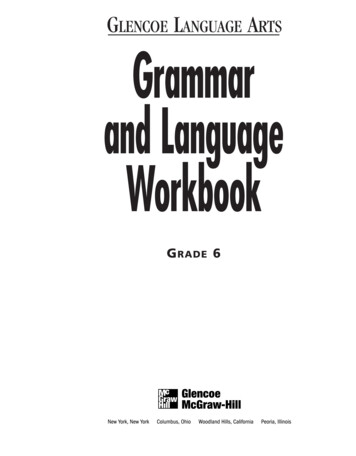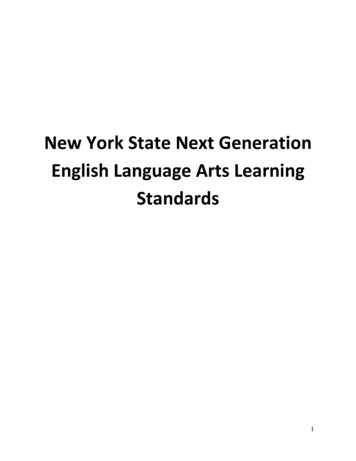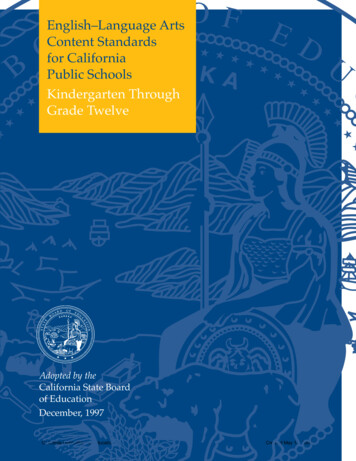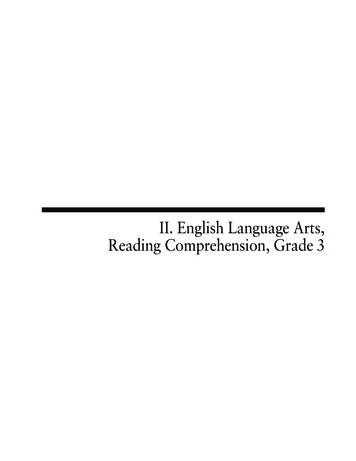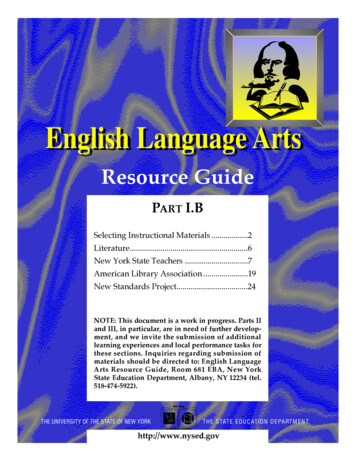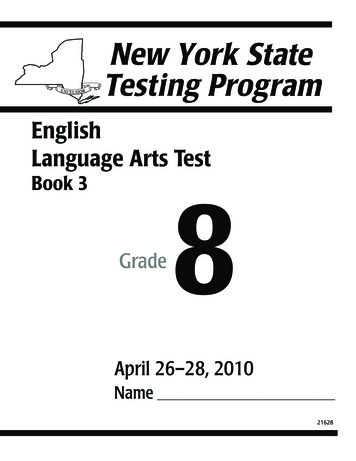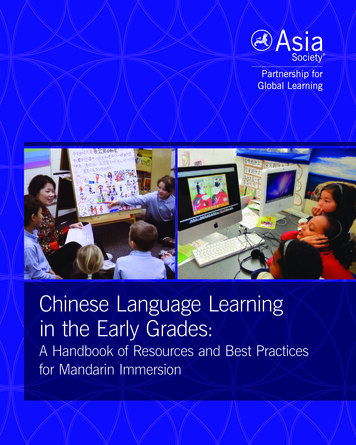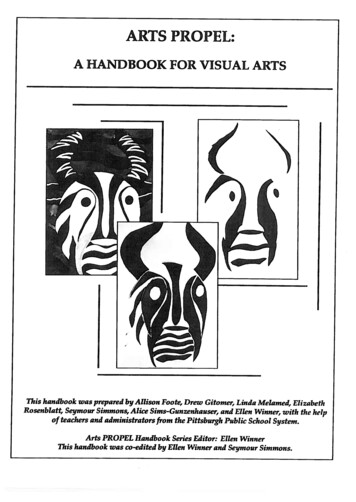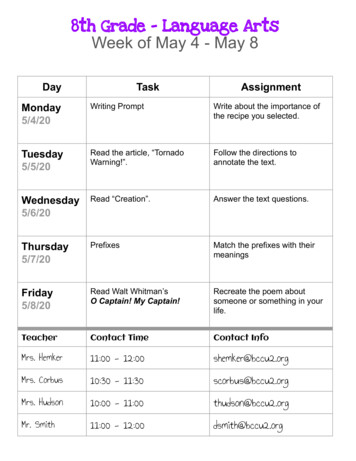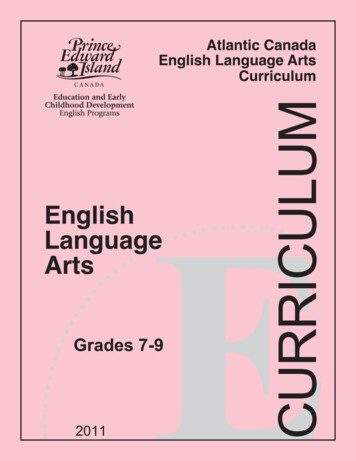
Transcription
English Language Arts 7-9February 2011
ACKNOWLEDGMENTSAcknowledgmentsThe Council of Atlantic Ministers of Education and Training (CAMET) and the departments of education ofNew Brunswick, Newfoundland and Labrador, Nova Scotia, and Prince Edward Island gratefully acknowledgethe contribution of the regional English language arts common curriculum committee to the revised curriculumguide. Committee members include the following:New BrunswickTiffany BastinPrince Edward IslandCathy MontgomeryJarmo PuirasNewfoundland and LabradorJill HowlettCAMETSylvie MartinNova ScotiaBarry WilsonThe Council of Atlantic Ministers of Education and Training (CAMET) and the departments of education ofNew Brunswick, Newfoundland and Labrador, Nova Scotia, and Prince Edward Island gratefully acknowledge thefollowing provinces for granting permission to use the resources listed below.British ColumbiaEnglish Language Arts Grade 7: Integrated Resource Package (2006), English Language Arts Grade 8:Integrated Resource Package (2007), English Language Arts Grade 9: Integrated Resource Package (2007).Used with permission of British Columbia Ministry of Education.Nova ScotiaTeaching in Action, Grades 7-9: A Teaching Resource (2007). Adapted with permission from the Province ofNova Scotia Department of Education.Active Readers Grades 7–9 Assessment Resource: Young Adolescents (2005). Adapted with permission fromthe Province of Nova Scotia Department of Education.SaskatchewanEnglish Language Arts 9 (2008). Used with permission of Saskatchewan Ministry of Education.ATLANTIC CANADA ENGLISH LANGUAGE ARTS CURRICULUM GRADES 7-9iii
ACKNOWLEDGMENTSivATLANTIC CANADA ENGLISH LANGUAGE ARTS CURRICULUM GRADES 7-9
CONTENTSContentsList of IllustrationsxiIntroduction to English 7-9 Language ArtsBackground .3The Atlantic Cananda English Language Arts Curriculum .3Essential Graduation Learnings .4Connections between Essential Graduation Learnings and Key-Stage Curriculum Outcomes .4Purpose of the English 7-9 Curriculum Guide .7The Nature of English Language Arts .7Comprehension and Metacognition.8Definition of Text.8An Effective English Language Arts Program.9Zone of Proximal Development .9Gradual Release of Responsibility .10Contexts for Learning and Teaching in English 7-9 .11Principles Underlying the English Language Arts Curriculum .11Considerations for Program DeliveryThe Learning Environment .17Developmental Characteristics of Adolescents .17Intellectual Development .17Social Development .18Physical Development .18Emotional and Psychological Development .19Moral Development .19The Role of the Teacher .20Establishing Community in the English Language Arts Classroom.20Meeting the Needs of All Students .22Valuing Equity and Diversity .22Students with Exceptionalities .24English as an Additional Language (EAL) Students .25Students with Language and Communication Challenges .25Advanced Learners .26Engaging All Students .26Student Learning Preferences .27Resource-Based Learning .28Differentiated Instruction.29Differentiating by Content .29Differentiating by Process.30Differentiating by Product .31Opportunities for Student Choice .31Differentiating the Learning Environment .32ATLANTIC CANADA ENGLISH LANGUAGE ARTS CURRICULUM GRADES 7-9v
CONTENTSA Framework for Balanced Instruction in English Language Arts. 33Selecting Strategies . 33Workshop Approach . 34The Speaking and Listening Strand . 35Expectations for Speaking and Listening . 35The Role of the Teacher . 36Organizing the Speaking and Listening Environment . 37Organizing for Speaking and Listening Instruction . 37Speaking . 38Listening . 39Focuses for the Strand . 40The Reading and Viewing Strand . 42Expectations for Reading and Viewing . 42The Role of the Teacher . 43Organizing the Reading and Viewing Environment . 44Organizing for Reading and Viewing Instruction . 44Varying the Reading and Viewing Experience . 47Reading Workshop . 48Stages of Reading Development . 48Reading Strategies . 49Focuses for the Strand . 51The Writing and Representing Strand . 53Expectations for Writing and Representing . 53The Role of the Teacher . 53Organizing for Writing and Representing Instruction . 54Writing Workshop . 55Focus Lessons . 56Expressive or Exploratory Writing . 56Transactional Writing . 57Poetic Writing . 57Determining Purpose . 58Determining Audience . 58Determining Form . 58Text Forms . 59Representing . 61Focuses for the Strand . 63Organizing Learning Experiences for Students . 65The Workshop: A Framework for Instruction. 65Time to Teach . 66Time to Practise and Develop. 67Time to Share and Reflect . 69Integrated Teaching and Learning . 72Inquiry-Based Learning . 72viATLANTIC CANADA ENGLISH LANGUAGE ARTS CURRICULUM GRADES 7-9
CONTENTSContent Elements .73Literacy Learning .73Metacognition.73Developing Multiple Literacies.74Media Literacy .74Media Awareness .75Critical Literacy .76Visual Literacy .77Information Literacy .78Areas of Text Inquiry in English 7-9 .79Understanding Texts.80Responding to Texts .81Personal Responses .82Critical Responses .83The Role of Literature .84Literary Genres .85Responding to Literature.88Poetry .89Drama .89Role-Play.89Readers Theatre.90Reader’s Notebook .91Online Interaction .91Essays .91Research as Inquiry .91The Role of the Teacher .92Sharing Learning Resources.94Stages of Inquiry .95Planning .95Gathering Information.96Interacting with Information .96Synthesizing Information .97Assessment and Evaluation.97The Processes of Writing .100Inquiry Strategies for Writing .102Prewriting .102Drafting Strategies for Writing .102Organizing .102Drafting .102Product Strategies for Writing .103Revising .103Publishing .104Conferring with Students .105Content Conferences .105Editing Conferences.106Conference Prompts .107ATLANTIC CANADA ENGLISH LANGUAGE ARTS CURRICULUM GRADES 7-9vii
CONTENTSAssessing and Evaluating Student AchievementIntroduction .111Assessment .111Purposes of Assessment .112Assessment for Learning .112Assessment as Learning .113Assessment of Learning.114Designing Effective Assessments .114Rubrics.116The Role of the Teacher .117Providing Feedback to Students .119Assessment Planning Summary .120Involving Students in the Assessment Process .122Assessment Tools .122Portfolios .125Tests and Examinations .125Understanding the Student Achievement Standards .126Application of the Standards .126Planning for Individual Instruction .126Assessing Speaking and Listening .127Assessing Reading and Viewing.132Assessing Writing and Representing .136Using “Traits of Writing” Appropriate Indicators of Achievement .138Assessing Students’ Responses to Text .139Evaluation.142Curriculum OutcomesIntroduction . 145General Curriculum Outcomes (GCOs) . 145Key-Stage Curriculum Outcomes . 146Specific Curriculum Outcomes (SCOs) . 151Speaking and Listening Overview. 151Reading and Viewing Overview . 154Writing and Representing Overview . 157viiiATLANTIC CANADA ENGLISH LANGUAGE ARTS CURRICULUM GRADES 7-9
CONTENTSGrade 7Speaking and Listening Strand . 161Framework . 163Assessment Suggestions . 164Curriculum Outcomes, Student Achievement Standards, and Suggestions forLearning and Teaching . 165Reading and Viewing Strand . 171Framework . 173Reading Achievement Standards. 174Assessment Suggestions . 175Curriculum Outcomes, Student Achievement Standards, and Suggestions forLearning and Teaching . 176Writing and Representing Strand . 189Framework . 191Writing Achievement Standards. . 192Assessment Suggestions . 193Curriculum Outcomes, Student Achievement Standards, and Suggestions forLearning and Teaching . 198Grade 8Speaking and Listening Strand . 207Framework . 209Assessment Suggestions . 210Curriculum Outcomes, Student Achievement Standards, and Suggestions forLearning and Teaching . 211Reading and Viewing Strand . 217Framework . 219Reading Achievement Standards. 220Assessment Suggestions . 221Curriculum Outcomes, Student Achievement Standards, and Suggestions forLearning and Teaching . 223Writing and Representing Strand . 235Framework . 237Writing Achievement Standards . 238Assessment Suggestions . 239Curriculum Outcomes, Student Achievement Standards, and Suggestions forLearning and Teaching . 244ATLANTIC CANADA ENGLISH LANGUAGE ARTS CURRICULUM GRADES 7-9ix
CONTENTSGrade 9Speaking and Listening Strand .255Framework .257Assessment Suggestions .258Curriculum Outcomes, Student Achievement Standards, and Suggestions forLearning and Teaching .259Reading and Viewing Strand .265Framework .267Reading Achievement Standards .268Assessment Suggestions .269Curriculum Outcomes, Student Achievement Standards, and Suggestions forLearning and Teaching .271Writing and Representing Strand .283Framework .285Writing Achievement Standards .286Assessment Suggestions .287Curriculum Outcomes, Student Achievement Standards, and Suggestions forLearning and Teaching .292AppendicesA - Speaking and Listening . 305B - Reading and Viewing . 329C - Writing and Representing . 367D - Planning for Balanced Instruction in English Language Arts . 395E - Overview of Grades 6-10 SCOs . 401Glossary of TermsGlossary of Terms.413BibliographyReferences for English 7-9 . 431IndexIndex of Terms. . 437xATLANTIC CANADA ENGLISH LANGUAGE ARTS CURRICULUM GRADES 7-9
CONTENTSIllustrationsFiguresFigure 1: The Nature of English Language Arts .8Figure 2: Gradual Release of Responsibililty .10Figure 3: The Nature of English Language Arts .33Figure 4: Level of Teacher Support .62Figure 5: Workshop as a Framework for Instruction .65Figure 6: Stages of Inquiry .99Figure 7: Processes of Writing .101Figure 8: Reading Workshop .335Figure 9: Writing Workshop .373TablesTable 1: Key-Stage Curriculum Outcomes . 5Table 2: What English Language Arts Is/Is Not . 13Table 3: Types of Listening. 39Table 4: Focuses for Speaking and Listening. 40Table 5: Characteristics of Effective Vocabulary Instruction . 45Table 6: Stages of Reading Development. 49Table 7: Reading Comprehension Strategies . 50Table 8: Focuses for Reading and Viewing . 51Table 9: Focuses for Writing and Representing . 63Table 10: Learning Experiences . 71Table 11: Specific Areas of
English Language Arts Grade 7: Integrated Resource Package (2006), English Language Arts Grade 8: Integrated Resource Package (2007), English Language Arts Grade 9: Integrated Resource Package (2007). Used with permission of British Columbia Ministry of Education. Nova Scotia Teaching in Ac

